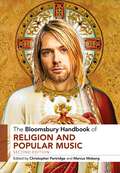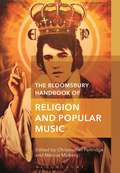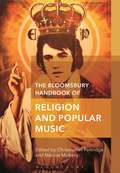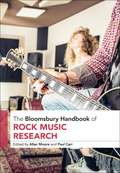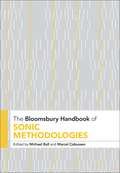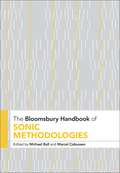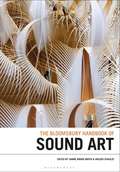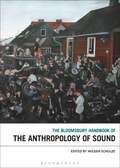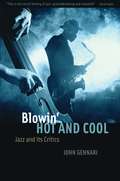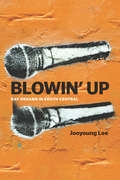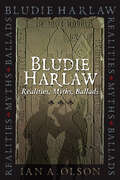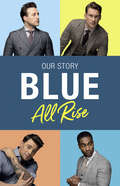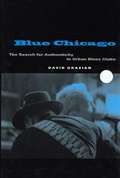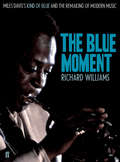- Table View
- List View
The Bloomsbury Handbook of Religion and Popular Music (Bloomsbury Handbooks)
by Christopher Partridge and Marcus MobergThe second edition of The Bloomsbury Handbook of Religion and Popular Music provides an updated, state-of-the-art analysis of the most important themes and concepts in the field, combining research in religious studies, theology, critical musicology, cultural analysis, and sociology. It comprises 30 updated essays and six new chapters covering the following areas: · Popular Music, Religion, and Performance · Musicological Perspectives · Popular Music and Religious Syncretism · Atheism and Popular Music · Industrial Music and Noise· K-pop The Handbook continues to provide a guide to methodology, key genres and popular music subcultures, as well as an extensive updated bibliography. It remains the essential tool for anyone with an interest in popular culture generally and religion and popular music in particular.
The Bloomsbury Handbook of Religion and Popular Music (Bloomsbury Handbooks in Religion)
by Christopher Partridge Marcus MobergThe Bloomsbury Handbook of Religion and Popular Music is the first comprehensive analysis of the most important themes and concepts in this field. Drawing on contemporary research from religious studies, theology, sociology, ethnography, and cultural studies, the volume comprises thirty-one specifically commissioned essays from a team of international experts. The chapters explore the principal areas of inquiry and point to new directions for scholarship. Featuring chapters on methodology, key genres, religious traditions and popular music subcultures, this volume provides the essential reference point for anyone with an interest in religion and popular music as well as popular culture more broadly. Religious traditions covered include Christianity, Islam, Judaism, Hinduism, Buddhism, Paganism and occultism. Coverage of genres and religion ranges from heavy metal, rap and hip hop to country music and film and television music. Edited by Christopher Partridge and Marcus Moberg, this Handbook defines the research field and provides an accessible entry point for new researchers in the field.
The Bloomsbury Handbook of Religion and Popular Music (Bloomsbury Handbooks in Religion)
by Christopher Partridge Marcus MobergThe Bloomsbury Handbook of Religion and Popular Music is the first comprehensive analysis of the most important themes and concepts in this field. Drawing on contemporary research from religious studies, theology, sociology, ethnography, and cultural studies, the volume comprises thirty-one specifically commissioned essays from a team of international experts. The chapters explore the principal areas of inquiry and point to new directions for scholarship. Featuring chapters on methodology, key genres, religious traditions and popular music subcultures, this volume provides the essential reference point for anyone with an interest in religion and popular music as well as popular culture more broadly. Religious traditions covered include Christianity, Islam, Judaism, Hinduism, Buddhism, Paganism and occultism. Coverage of genres and religion ranges from heavy metal, rap and hip hop to country music and film and television music. Edited by Christopher Partridge and Marcus Moberg, this Handbook defines the research field and provides an accessible entry point for new researchers in the field.
The Bloomsbury Handbook of Religion and Popular Music (Bloomsbury Handbooks)
The second edition of The Bloomsbury Handbook of Religion and Popular Music provides an updated, state-of-the-art analysis of the most important themes and concepts in the field, combining research in religious studies, theology, critical musicology, cultural analysis, and sociology. It comprises 30 updated essays and six new chapters covering the following areas: · Popular Music, Religion, and Performance · Musicological Perspectives · Popular Music and Religious Syncretism · Atheism and Popular Music · Industrial Music and Noise· K-pop The Handbook continues to provide a guide to methodology, key genres and popular music subcultures, as well as an extensive updated bibliography. It remains the essential tool for anyone with an interest in popular culture generally and religion and popular music in particular.
The Bloomsbury Handbook of Rock Music Research (Bloomsbury Handbooks)
by Allan Moore Paul CarrThe Bloomsbury Handbook of Rock Music Research is the first comprehensive academic survey of the field of rock music as it stands today. More than 50 years into its life and we still ask - what is rock music, why is it studied, and how does it work, both as music and as cultural activity? This volume draws together 37 of the leading academics working on rock to provide answers to these questions and many more. The text is divided into four major sections: practice of rock (analysis, performance, and recording); theories; business of rock; and social and culture issues. Each chapter combines two approaches, providing a summary of current knowledge of the area concerned as well as the consequences of that research and suggesting profitable subsequent directions to take. This text investigates and presents the field at a level of depth worthy of something which has had such a pervasive influence on the lives of millions.
The Bloomsbury Handbook of Rock Music Research (Bloomsbury Handbooks)
The Bloomsbury Handbook of Rock Music Research is the first comprehensive academic survey of the field of rock music as it stands today. More than 50 years into its life and we still ask - what is rock music, why is it studied, and how does it work, both as music and as cultural activity? This volume draws together 37 of the leading academics working on rock to provide answers to these questions and many more. The text is divided into four major sections: practice of rock (analysis, performance, and recording); theories; business of rock; and social and culture issues. Each chapter combines two approaches, providing a summary of current knowledge of the area concerned as well as the consequences of that research and suggesting profitable subsequent directions to take. This text investigates and presents the field at a level of depth worthy of something which has had such a pervasive influence on the lives of millions.
The Bloomsbury Handbook of Sonic Methodologies (Bloomsbury Handbooks)
by Michael Bull and Marcel CobussenThe field of Sound Studies has changed and developed dramatically over the last two decades involving a vast and dizzying array of work produced by those working in the arts, social sciences and sciences. The study of sound is inherently interdisciplinary and is undertaken both by those who specialize in sound and by others who wish to include sound as an intrinsic and indispensable element in their research. This is the first resource to provide a wide ranging, cross-cultural and interdisciplinary investigation and analysis of the ways in which researchers use a broad range of methodologies in order to pursue their sonic investigations. It brings together 49 specially commissioned chapters that ask a wide range of questions including; how can sound be used in current academic disciplines? Is sound as a methodological tool indispensable for Sound Studies and what can sound artists contribute to the discourse on methodology in Sound Studies? The editors also present 3 original chapters that work as provocative 'sonic methodological interventions' prefacing the 3 sections of the book.
The Bloomsbury Handbook of Sonic Methodologies (Bloomsbury Handbooks)
The field of Sound Studies has changed and developed dramatically over the last two decades involving a vast and dizzying array of work produced by those working in the arts, social sciences and sciences. The study of sound is inherently interdisciplinary and is undertaken both by those who specialize in sound and by others who wish to include sound as an intrinsic and indispensable element in their research. This is the first resource to provide a wide ranging, cross-cultural and interdisciplinary investigation and analysis of the ways in which researchers use a broad range of methodologies in order to pursue their sonic investigations. It brings together 49 specially commissioned chapters that ask a wide range of questions including; how can sound be used in current academic disciplines? Is sound as a methodological tool indispensable for Sound Studies and what can sound artists contribute to the discourse on methodology in Sound Studies? The editors also present 3 original chapters that work as provocative 'sonic methodological interventions' prefacing the 3 sections of the book.
The Bloomsbury Handbook of Sound Art (Bloomsbury Handbooks)
by Holger Schulze Sanne Krogh GrothThe Bloomsbury Handbook of Sound Art explores and delineates what Sound Art is in the 21st century. Sound artworks today embody the contemporary and transcultural trends towards the post-apocalyptic, a wide sensorial spectrum of sonic imaginaries as well as the decolonization and deinstitutionalization around the making of sound. Within the areas of musicology, art history, and, later, sound studies, Sound Art has evolved at least since the 1980s into a turbulant field of academic critique and aesthetic analysis. Summoning artists, researchers, curators, and critics, this volume takes note of and reflects the most recent shifts and drifts in Sound Art--rooted in sonic histories and implying future trajectories.
The Bloomsbury Handbook of Sound Art (Bloomsbury Handbooks)
The Bloomsbury Handbook of Sound Art explores and delineates what Sound Art is in the 21st century. Sound artworks today embody the contemporary and transcultural trends towards the post-apocalyptic, a wide sensorial spectrum of sonic imaginaries as well as the decolonization and deinstitutionalization around the making of sound. Within the areas of musicology, art history, and, later, sound studies, Sound Art has evolved at least since the 1980s into a turbulant field of academic critique and aesthetic analysis. Summoning artists, researchers, curators, and critics, this volume takes note of and reflects the most recent shifts and drifts in Sound Art--rooted in sonic histories and implying future trajectories.
The Bloomsbury Handbook of the Anthropology of Sound (Bloomsbury Handbooks)
by Holger SchulzeThe Bloomsbury Handbook of the Anthropology of Sound presents the key subjects and approaches of anthropological research into sound cultures. What are the common characteristics as well as the inconsistencies of living with and around sound in everyday life? This question drives research in this interdisciplinary area of sound studies: it propels each main chapter of this handbook into a thoroughly different world of listening, experiencing, receiving, sensing, dreaming, naming, desiring, and crafting sound. This handbook is composed of six sections: sonic artifacts; sounds and the body; habitat and sound; sonic desires; sounds and machines; and overarching sensologies. The individual chapters explore exemplary research objects and put them in the context of methodological approaches, historical predecessors, research practices, and contemporary research gaps. This volume offers therefore one of the broadest, most detailed, and instructive overviews on current research in this area of sensory anthropology.
The Bloomsbury Handbook of the Anthropology of Sound (Bloomsbury Handbooks)
The Bloomsbury Handbook of the Anthropology of Sound presents the key subjects and approaches of anthropological research into sound cultures. What are the common characteristics as well as the inconsistencies of living with and around sound in everyday life? This question drives research in this interdisciplinary area of sound studies: it propels each main chapter of this handbook into a thoroughly different world of listening, experiencing, receiving, sensing, dreaming, naming, desiring, and crafting sound. This handbook is composed of six sections: sonic artifacts; sounds and the body; habitat and sound; sonic desires; sounds and machines; and overarching sensologies. The individual chapters explore exemplary research objects and put them in the context of methodological approaches, historical predecessors, research practices, and contemporary research gaps. This volume offers therefore one of the broadest, most detailed, and instructive overviews on current research in this area of sensory anthropology.
Blowin' Hot and Cool: Jazz and Its Critics
by John GennariIn the illustrious and richly documented history of American jazz, no figure has been more controversial than the jazz critic. Jazz critics can be revered or reviled—often both—but they should not be ignored. And while the tradition of jazz has been covered from seemingly every angle, nobody has ever turned the pen back on itself to chronicle the many writers who have helped define how we listen to and how we understand jazz. That is, of course, until now. In Blowin’ Hot and Cool, John Gennari provides a definitive history of jazz criticism from the 1920s to the present. The music itself is prominent in his account, as are the musicians—from Louis Armstrong and Duke Ellington to Charlie Parker, John Coltrane, Roscoe Mitchell, and beyond. But the work takes its shape from fascinating stories of the tradition’s key critics—Leonard Feather, Martin Williams, Whitney Balliett, Dan Morgenstern, Gary Giddins, and Stanley Crouch, among many others. Gennari is the first to show the many ways these critics have mediated the relationship between the musicians and the audience—not merely as writers, but in many cases as producers, broadcasters, concert organizers, and public intellectuals as well. For Gennari, the jazz tradition is not so much a collection of recordings and performances as it is a rancorous debate—the dissonant noise clamoring in response to the sounds of jazz. Against the backdrop of racial strife, class and gender issues, war, and protest that has defined the past seventy-five years in America, Blowin’ Hot and Cool brings to the fore jazz’s most vital critics and the role they have played not only in defining the history of jazz but also in shaping jazz’s significance in American culture and life.
Blowin' Hot and Cool: Jazz and Its Critics
by John GennariIn the illustrious and richly documented history of American jazz, no figure has been more controversial than the jazz critic. Jazz critics can be revered or reviled—often both—but they should not be ignored. And while the tradition of jazz has been covered from seemingly every angle, nobody has ever turned the pen back on itself to chronicle the many writers who have helped define how we listen to and how we understand jazz. That is, of course, until now. In Blowin’ Hot and Cool, John Gennari provides a definitive history of jazz criticism from the 1920s to the present. The music itself is prominent in his account, as are the musicians—from Louis Armstrong and Duke Ellington to Charlie Parker, John Coltrane, Roscoe Mitchell, and beyond. But the work takes its shape from fascinating stories of the tradition’s key critics—Leonard Feather, Martin Williams, Whitney Balliett, Dan Morgenstern, Gary Giddins, and Stanley Crouch, among many others. Gennari is the first to show the many ways these critics have mediated the relationship between the musicians and the audience—not merely as writers, but in many cases as producers, broadcasters, concert organizers, and public intellectuals as well. For Gennari, the jazz tradition is not so much a collection of recordings and performances as it is a rancorous debate—the dissonant noise clamoring in response to the sounds of jazz. Against the backdrop of racial strife, class and gender issues, war, and protest that has defined the past seventy-five years in America, Blowin’ Hot and Cool brings to the fore jazz’s most vital critics and the role they have played not only in defining the history of jazz but also in shaping jazz’s significance in American culture and life.
Blowin' Hot and Cool: Jazz and Its Critics
by John GennariIn the illustrious and richly documented history of American jazz, no figure has been more controversial than the jazz critic. Jazz critics can be revered or reviled—often both—but they should not be ignored. And while the tradition of jazz has been covered from seemingly every angle, nobody has ever turned the pen back on itself to chronicle the many writers who have helped define how we listen to and how we understand jazz. That is, of course, until now. In Blowin’ Hot and Cool, John Gennari provides a definitive history of jazz criticism from the 1920s to the present. The music itself is prominent in his account, as are the musicians—from Louis Armstrong and Duke Ellington to Charlie Parker, John Coltrane, Roscoe Mitchell, and beyond. But the work takes its shape from fascinating stories of the tradition’s key critics—Leonard Feather, Martin Williams, Whitney Balliett, Dan Morgenstern, Gary Giddins, and Stanley Crouch, among many others. Gennari is the first to show the many ways these critics have mediated the relationship between the musicians and the audience—not merely as writers, but in many cases as producers, broadcasters, concert organizers, and public intellectuals as well. For Gennari, the jazz tradition is not so much a collection of recordings and performances as it is a rancorous debate—the dissonant noise clamoring in response to the sounds of jazz. Against the backdrop of racial strife, class and gender issues, war, and protest that has defined the past seventy-five years in America, Blowin’ Hot and Cool brings to the fore jazz’s most vital critics and the role they have played not only in defining the history of jazz but also in shaping jazz’s significance in American culture and life.
Blowin' Up: Rap Dreams in South Central
by Jooyoung LeeDr. Dre. Snoop Dogg. Ice Cube. Some of the biggest stars in hip hop made their careers in Los Angeles. And today there is a new generation of young, mostly black, men busting out rhymes and hoping to one day find themselves “blowin’ up”—getting signed to a record label and becoming famous. Many of these aspiring rappers get their start in Leimart Park, home to the legendary hip hop open-mic workshop Project Blowed. In Blowin’ Up, Jooyoung Lee takes us deep inside Project Blowed and the surrounding music industry, offering an unparalleled look at hip hop in the making. While most books on rap are written from the perspective of listeners and the market, Blowin’ Up looks specifically at the creative side of rappers. As Lee shows, learning how to rap involves a great deal of discipline, and it takes practice to acquire the necessary skills to put on a good show. Along with Lee—who is himself a pop-locker—we watch as the rappers at Project Blowed learn the basics, from how to hold a microphone to how to control their breath amid all those words. And we meet rappers like E. Crimsin, Nocando, VerBS, and Flawliss as they freestyle and battle with each other. For the men at Project Blowed, hip hop offers a creative alternative to the gang lifestyle, substituting verbal competition for physical violence, and provides an outlet for setting goals and working toward them. Engagingly descriptive and chock-full of entertaining personalities and real-life vignettes, Blowin’ Up not only delivers a behind-the-scenes view of the underground world of hip hop, but also makes a strong case for supporting the creative aspirations of young, urban, black men, who are often growing up in the shadow of gang violence and dead-end jobs.
Blowin' Up: Rap Dreams in South Central
by Jooyoung LeeDr. Dre. Snoop Dogg. Ice Cube. Some of the biggest stars in hip hop made their careers in Los Angeles. And today there is a new generation of young, mostly black, men busting out rhymes and hoping to one day find themselves “blowin’ up”—getting signed to a record label and becoming famous. Many of these aspiring rappers get their start in Leimart Park, home to the legendary hip hop open-mic workshop Project Blowed. In Blowin’ Up, Jooyoung Lee takes us deep inside Project Blowed and the surrounding music industry, offering an unparalleled look at hip hop in the making. While most books on rap are written from the perspective of listeners and the market, Blowin’ Up looks specifically at the creative side of rappers. As Lee shows, learning how to rap involves a great deal of discipline, and it takes practice to acquire the necessary skills to put on a good show. Along with Lee—who is himself a pop-locker—we watch as the rappers at Project Blowed learn the basics, from how to hold a microphone to how to control their breath amid all those words. And we meet rappers like E. Crimsin, Nocando, VerBS, and Flawliss as they freestyle and battle with each other. For the men at Project Blowed, hip hop offers a creative alternative to the gang lifestyle, substituting verbal competition for physical violence, and provides an outlet for setting goals and working toward them. Engagingly descriptive and chock-full of entertaining personalities and real-life vignettes, Blowin’ Up not only delivers a behind-the-scenes view of the underground world of hip hop, but also makes a strong case for supporting the creative aspirations of young, urban, black men, who are often growing up in the shadow of gang violence and dead-end jobs.
Blowin' Up: Rap Dreams in South Central
by Jooyoung LeeDr. Dre. Snoop Dogg. Ice Cube. Some of the biggest stars in hip hop made their careers in Los Angeles. And today there is a new generation of young, mostly black, men busting out rhymes and hoping to one day find themselves “blowin’ up”—getting signed to a record label and becoming famous. Many of these aspiring rappers get their start in Leimart Park, home to the legendary hip hop open-mic workshop Project Blowed. In Blowin’ Up, Jooyoung Lee takes us deep inside Project Blowed and the surrounding music industry, offering an unparalleled look at hip hop in the making. While most books on rap are written from the perspective of listeners and the market, Blowin’ Up looks specifically at the creative side of rappers. As Lee shows, learning how to rap involves a great deal of discipline, and it takes practice to acquire the necessary skills to put on a good show. Along with Lee—who is himself a pop-locker—we watch as the rappers at Project Blowed learn the basics, from how to hold a microphone to how to control their breath amid all those words. And we meet rappers like E. Crimsin, Nocando, VerBS, and Flawliss as they freestyle and battle with each other. For the men at Project Blowed, hip hop offers a creative alternative to the gang lifestyle, substituting verbal competition for physical violence, and provides an outlet for setting goals and working toward them. Engagingly descriptive and chock-full of entertaining personalities and real-life vignettes, Blowin’ Up not only delivers a behind-the-scenes view of the underground world of hip hop, but also makes a strong case for supporting the creative aspirations of young, urban, black men, who are often growing up in the shadow of gang violence and dead-end jobs.
Blowin' Up: Rap Dreams in South Central
by Jooyoung LeeDr. Dre. Snoop Dogg. Ice Cube. Some of the biggest stars in hip hop made their careers in Los Angeles. And today there is a new generation of young, mostly black, men busting out rhymes and hoping to one day find themselves “blowin’ up”—getting signed to a record label and becoming famous. Many of these aspiring rappers get their start in Leimart Park, home to the legendary hip hop open-mic workshop Project Blowed. In Blowin’ Up, Jooyoung Lee takes us deep inside Project Blowed and the surrounding music industry, offering an unparalleled look at hip hop in the making. While most books on rap are written from the perspective of listeners and the market, Blowin’ Up looks specifically at the creative side of rappers. As Lee shows, learning how to rap involves a great deal of discipline, and it takes practice to acquire the necessary skills to put on a good show. Along with Lee—who is himself a pop-locker—we watch as the rappers at Project Blowed learn the basics, from how to hold a microphone to how to control their breath amid all those words. And we meet rappers like E. Crimsin, Nocando, VerBS, and Flawliss as they freestyle and battle with each other. For the men at Project Blowed, hip hop offers a creative alternative to the gang lifestyle, substituting verbal competition for physical violence, and provides an outlet for setting goals and working toward them. Engagingly descriptive and chock-full of entertaining personalities and real-life vignettes, Blowin’ Up not only delivers a behind-the-scenes view of the underground world of hip hop, but also makes a strong case for supporting the creative aspirations of young, urban, black men, who are often growing up in the shadow of gang violence and dead-end jobs.
Blowin' Up: Rap Dreams in South Central
by Jooyoung LeeDr. Dre. Snoop Dogg. Ice Cube. Some of the biggest stars in hip hop made their careers in Los Angeles. And today there is a new generation of young, mostly black, men busting out rhymes and hoping to one day find themselves “blowin’ up”—getting signed to a record label and becoming famous. Many of these aspiring rappers get their start in Leimart Park, home to the legendary hip hop open-mic workshop Project Blowed. In Blowin’ Up, Jooyoung Lee takes us deep inside Project Blowed and the surrounding music industry, offering an unparalleled look at hip hop in the making. While most books on rap are written from the perspective of listeners and the market, Blowin’ Up looks specifically at the creative side of rappers. As Lee shows, learning how to rap involves a great deal of discipline, and it takes practice to acquire the necessary skills to put on a good show. Along with Lee—who is himself a pop-locker—we watch as the rappers at Project Blowed learn the basics, from how to hold a microphone to how to control their breath amid all those words. And we meet rappers like E. Crimsin, Nocando, VerBS, and Flawliss as they freestyle and battle with each other. For the men at Project Blowed, hip hop offers a creative alternative to the gang lifestyle, substituting verbal competition for physical violence, and provides an outlet for setting goals and working toward them. Engagingly descriptive and chock-full of entertaining personalities and real-life vignettes, Blowin’ Up not only delivers a behind-the-scenes view of the underground world of hip hop, but also makes a strong case for supporting the creative aspirations of young, urban, black men, who are often growing up in the shadow of gang violence and dead-end jobs.
Blowin' Up: Rap Dreams in South Central
by Jooyoung LeeDr. Dre. Snoop Dogg. Ice Cube. Some of the biggest stars in hip hop made their careers in Los Angeles. And today there is a new generation of young, mostly black, men busting out rhymes and hoping to one day find themselves “blowin’ up”—getting signed to a record label and becoming famous. Many of these aspiring rappers get their start in Leimart Park, home to the legendary hip hop open-mic workshop Project Blowed. In Blowin’ Up, Jooyoung Lee takes us deep inside Project Blowed and the surrounding music industry, offering an unparalleled look at hip hop in the making. While most books on rap are written from the perspective of listeners and the market, Blowin’ Up looks specifically at the creative side of rappers. As Lee shows, learning how to rap involves a great deal of discipline, and it takes practice to acquire the necessary skills to put on a good show. Along with Lee—who is himself a pop-locker—we watch as the rappers at Project Blowed learn the basics, from how to hold a microphone to how to control their breath amid all those words. And we meet rappers like E. Crimsin, Nocando, VerBS, and Flawliss as they freestyle and battle with each other. For the men at Project Blowed, hip hop offers a creative alternative to the gang lifestyle, substituting verbal competition for physical violence, and provides an outlet for setting goals and working toward them. Engagingly descriptive and chock-full of entertaining personalities and real-life vignettes, Blowin’ Up not only delivers a behind-the-scenes view of the underground world of hip hop, but also makes a strong case for supporting the creative aspirations of young, urban, black men, who are often growing up in the shadow of gang violence and dead-end jobs.
Bludie Harlaw: Realities, Myths, Ballads
by Ian A. OlsonIn the summer of 1411, the ageing Donald of Isla, Lord of the Isles, invaded mainland Scotland with a huge, battle-hardened army, only to be fought to a bloody standstill on the plateau of Harlaw, fifteen miles from Aberdeen, a town he had threatened to sack. One of the greatest battles in Scottish history, described by hardened mediaeval chroniclers as 'atrocious', 'Reid Harlaw' left some 3,000 dead and wounded. Dismissed by Scott as a 'Celt v. Saxon' power struggle, it has faded from historical memory, other than in the north-east of Scotland.Written records in Latin, Scots, Gaelic and English are presented in their original form, and with transcriptions and translations. Two major ballads are analysed, one contemporary, and one fabricated over 350 years later - which is still sung. Lowland views dominate, because of the loss and destruction of Highland records, notably those of the Lords of the Isles themselves. The histories themselves fall into two groups - those written at or around the time, and those composed some 300 years later. These later accounts form the basis of most modern descriptions of the battle, but they tend to be romantic and highly imaginative, creating noble order where chaos once existed.
Blue: Our Story
by Antony Costa Duncan James Lee Ryan Simon WebbeFor the first time, more than 15 years after four boys from London were first thrown together to form what would go on to become one of the most successful and infamous groups of the boyband era, Lee, Antony, Duncan and Simon tell their full, no-holds-barred story in their own inimitable words.
Blue Chicago: The Search for Authenticity in Urban Blues Clubs
by David GrazianThe club is run-down and dimly lit. Onstage, a black singer croons and weeps of heartbreak, fighting back the tears. Wisps of smoke curl through the beam of a single spotlight illuminating the performer. For any music lover, that image captures the essence of an authentic experience of the blues. In Blue Chicago, David Grazian takes us inside the world of contemporary urban blues clubs to uncover how such images are manufactured and sold to music fans and audiences. Drawing on countless nights in dozens of blues clubs throughout Chicago, Grazian shows how this quest for authenticity has transformed the very shape of the blues experience. He explores the ways in which professional and amateur musicians, club owners, and city boosters define authenticity and dish it out to tourists and bar regulars. He also tracks the changing relations between race and the blues over the past several decades, including the increased frustrations of black musicians forced to slog through the same set of overplayed blues standards for mainly white audiences night after night. In the end, Grazian finds that authenticity lies in the eye of the beholder: a nocturnal fantasy to some, an essential way of life to others, and a frustrating burden to the rest. From B.L.U.E.S. and the Checkerboard Lounge to the Chicago Blues Festival itself, Grazian's gritty and often sobering tour in Blue Chicago shows us not what the blues is all about, but why we care so much about that question.
The Blue Moment: Miles Davis's Kind of Blue and the Remaking of Modern Music
by Richard Williams'It is the most singular of sounds, yet among the most ubiquitous. It is the sound of isolation that has sold itself to millions.'Miles Davis's Kind of Blue is the best selling piece of music in the history of jazz, and for many listeners among the most haunting in all of twentieth-century music. It is also, notoriously, the only jazz album many people own. Recorded in 1959 (in nine miraculous hours), there has been nothing like it since. Its atmosphere - slow, dark, meditative, luminous - became all-pervasive for a generation, and has remained the epitome of melancholy coolness ever since.Richard Williams has written a history of the album which for once does not rip it out of its wider cultural context. He evokes the essence of the music - identifying the qualities that make it so uniquely appealing - while making effortless connections to painting, literature, philosophy and poetry. This makes for an elegant, graceful and beautifully-written narrative.
